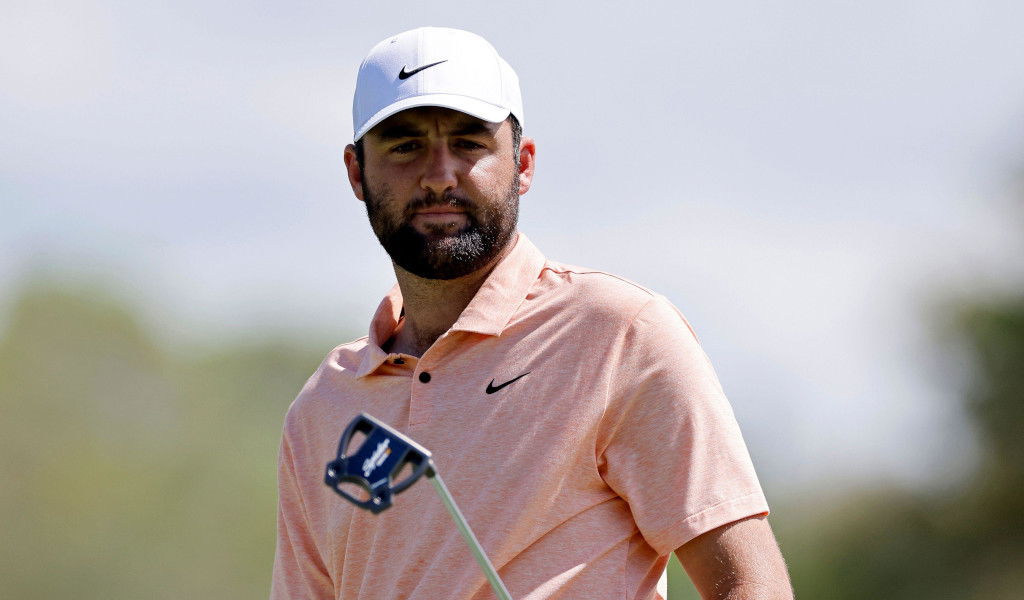
Imago
2WPHG35 ORLANDO, FL – MARCH 07: Scottie Scheffler of the United States reacts after a missed putt at the 12th hole during the first round of the Arnold Palmer Invitational presented by Mastercard at Arnold Palmer Bay Hill Golf Course on March 07, 2024 in Orlando, Florida. (Photo by Joe Robbins/Icon Sportswire) (Icon Sportswire via AP Images)

Imago
2WPHG35 ORLANDO, FL – MARCH 07: Scottie Scheffler of the United States reacts after a missed putt at the 12th hole during the first round of the Arnold Palmer Invitational presented by Mastercard at Arnold Palmer Bay Hill Golf Course on March 07, 2024 in Orlando, Florida. (Photo by Joe Robbins/Icon Sportswire) (Icon Sportswire via AP Images)
Sometimes, 72 holes in a PGA Championship feel like just a warm-up, as if the players are merely teasing us with their skills before the real show begins! This possibility intensifies with the current crowded leaderboard at Quail Hollow, where four golfers are within five strokes of the leader, Scottie Scheffler. With such a tight race, the chances of a playoff remain very much alive. But what happens if that ever happens?
Watch What’s Trending Now!
In the beginning, players compete in groups of three, with the first two rounds taking place in the morning and afternoon. After 36 holes, only the top 70 players and ties advance, and in the final rounds, organizers pair players based on their scores, with the lowest scores teeing off last. However, it gets a little more interesting when the PGA Championship reaches a possible playoff moment.
When the PGA Championship heads into a playoff due to a tie after 72 holes, it uses a three-hole aggregate playoff format. The specific holes typically played are 16, 17, and 18, and the player with the lowest combined score on these three holes wins. If the players remain tied after this initial playoff, they move to a sudden-death format, playing hole by hole until one player scores lower than the other.
ADVERTISEMENT
This playoff format has been in use since 2000, maintaining the three-hole aggregate score system that began that year. The longest playoff in the stroke play era occurred in 1961 and 1967, when golfers played a full 18 holes to determine a winner. In 1972, officials changed the format to sudden death, making it more exciting by combining aggregate scoring with sudden death to ensure a clear winner. Notably, the PGA Championship is the only major tournament that uses a three-hole playoff format.
Relive Scottie Scheffler’s BEST shots from the Green Mile yesterday! 👏#PGAChamp pic.twitter.com/6IDUjZg3bj
— PGA Championship (@PGAChampionship) May 18, 2025
In the PGA Championship, the order in which players tee off differs from many other tournaments. It does not rely on who has the lowest overall score or who is leading after a specific round. Instead, players draw numbers on the 16th tee to establish their starting order. After the first hole, the player with the lowest score on that hole tees off first on the next hole. If two or more players tie for the lowest score, the honor goes to the player who teed off first on the previous hole. The last PGA Championship playoff happened between Justin Thomas and Will Zalatoris in 2022, where Thomas went on to win his second PGA Championship. However, one of the most iconic playoffs happened a quarter of a century ago!
ADVERTISEMENT
Top Stories
LIV Golf Issues Statement as Pro Announces Shock Retirement After Getting Relegated

Calls Mount Against PNC Championship TV Coverage as Tiger Woods & Charlie Woods’ Absence Felt

Johnson Wagner Admits Guilt for Making Jordan Spieth Miss Out on Rare PGA Tour Record

Amanda Balionis Receives Wake-Up Call That She Didn’t Expect to Face at 39

Praise Pours In for Annika Sörenstam After Her Gesture Toward Matt Kuchar and Son Despite PNC Loss

Tiger Woods vs Bob May, 2000 PGA Championship playoff
Talking 25 years after the epic showdown between Tiger Woods and himself at the 2000 PGA Championship, Bob May said earlier this month, “Of course, I was nervous on the first tee on Sunday afternoon, but I bet Tiger was, too.” Given the intensity displayed during the match, we are not surprised by that statement. The 2000 PGA Championship at Valhalla Golf Club stands out as one of the most exciting matchups in golf history, largely because of the surprising contest between Tiger Woods and Bob May.
ADVERTISEMENT
As the tournament continued, Woods took a slim lead into the final round, but May delivered an outstanding performance. After a slow start, May made a strong comeback with several birdies. Woods, renowned for his ability to close out tournaments, found himself in an unusual situation where he had to fight to keep pace with May. In the final round, both players made key putts and showcased their skills. Woods encountered challenges early on but managed to tie the match by the end of regulation, which led to a playoff.
During the playoff, Woods took the lead by making a birdie on the 16th hole, showcasing his signature clutch putting. May could not keep pace with Woods in the closing holes. A fortunate break for Woods, where his wayward drive bounced back into a more advantageous position, further shifted the odds in his favor. In the end, Woods secured the win with a par on the 18th hole, while May narrowly missed a birdie putt that could have extended the match. Phew! What would fans do to witness that live once again!
ADVERTISEMENT
ADVERTISEMENT
ADVERTISEMENT

